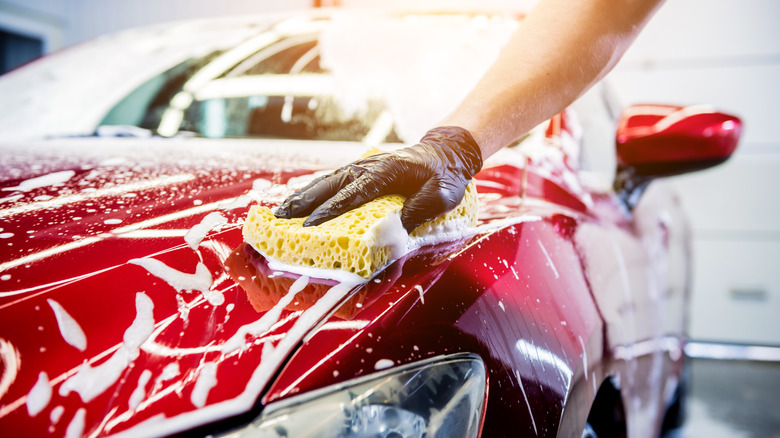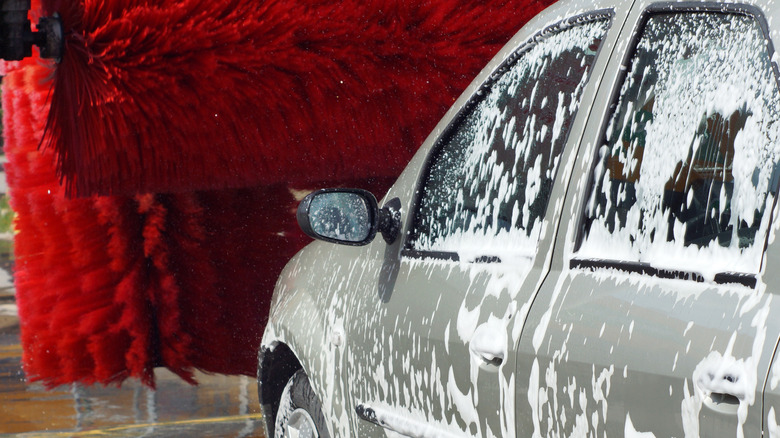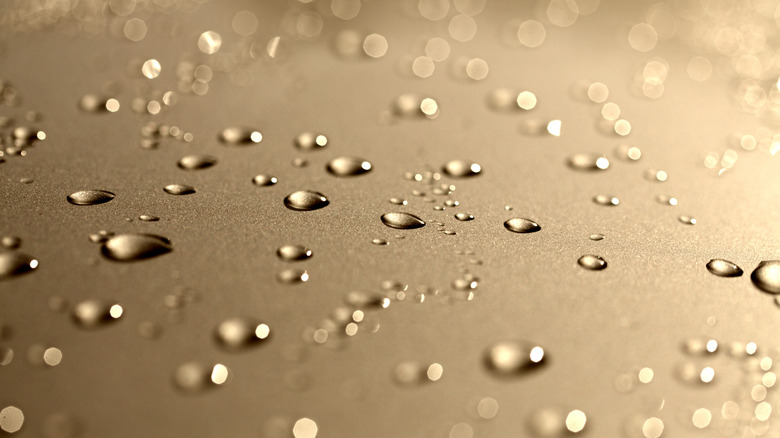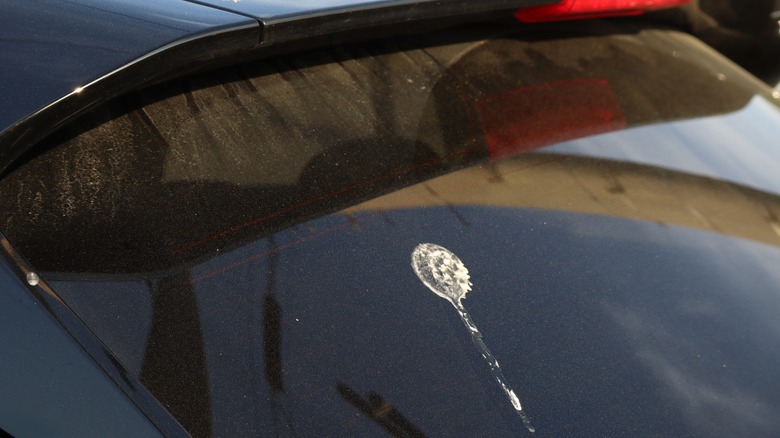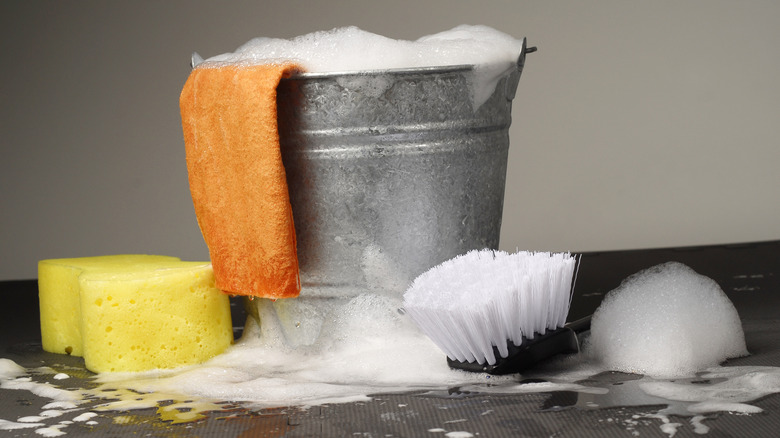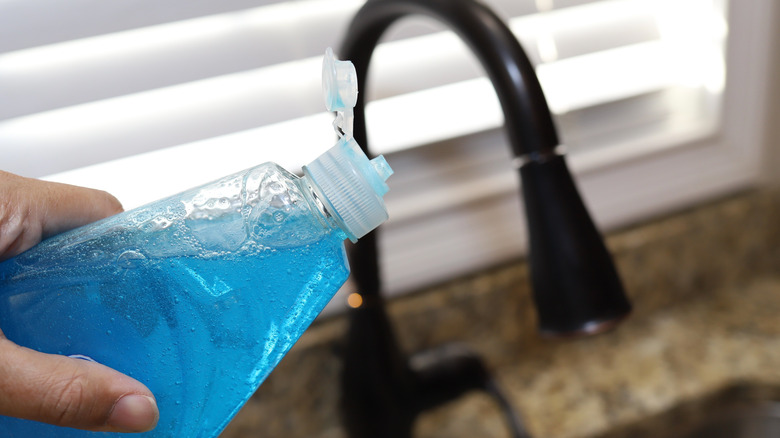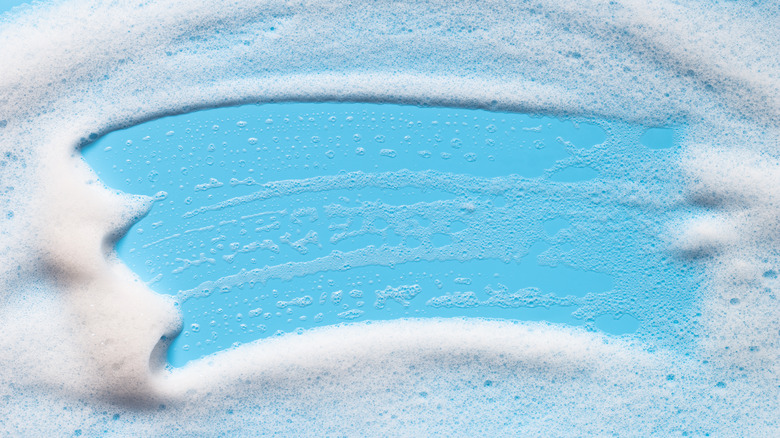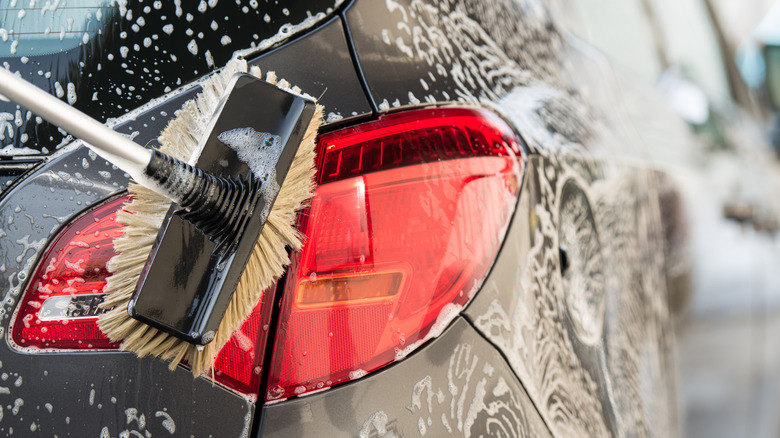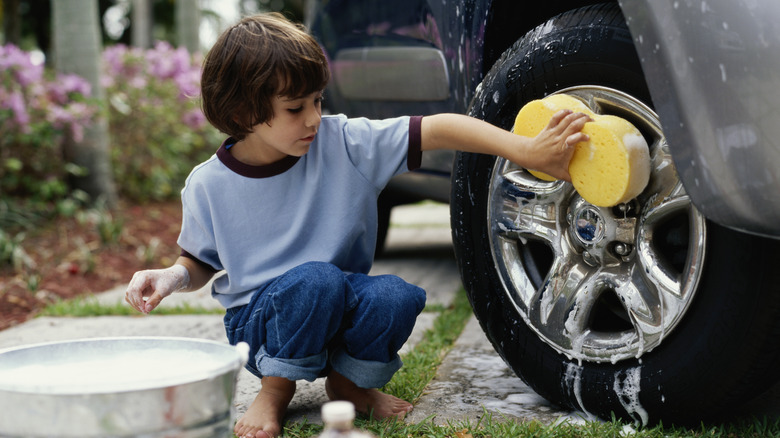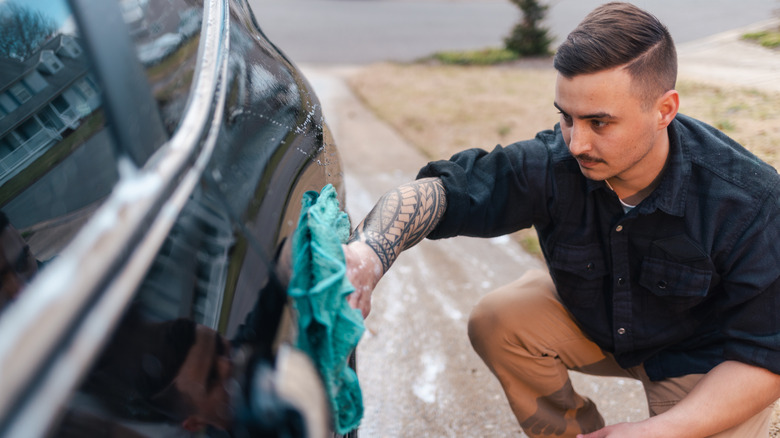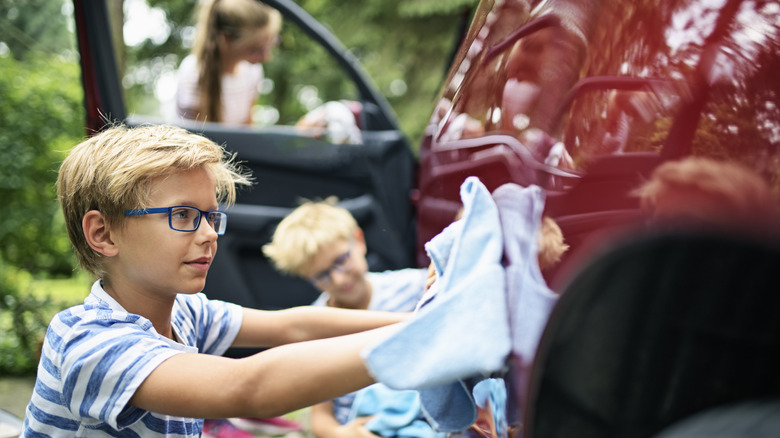10 Mistakes You Might Be Making When Washing Your Car
Car lovers the world over like to spend time taking care of their cars, and that includes cleaning them inside and out. After all, what's the point of owning and driving a nice car unless you're keeping it in pristine condition? Washing your car regularly isn't just about keeping up appearances either. If you wash it well, and keep it waxed and polished, your efforts can preserve the paintwork and prolong the life of your car.
However, as important as the practice is, there are lots of mistakes people make when washing their cars. This includes experienced car owners who really should know better. With that in mind, we have compiled a list of mistakes to avoid in order to ensure you're not doing more harm than good to your beloved automobile. From using abrasive cleaning products to forgetting to clean the less obvious parts of your car, here's what not to do when washing your car.
Using an automatic car wash
For the best car wash, do it yourself by hand. Yes, we know that washing your car can be a chore, sucking away your precious weekend downtime, and that going to a car wash is convenient. However, washing your car yourself is the only real way to do it to your exacting standards. Of course, you could have it washed by hand by a professional — however, not only is that expensive, it leaves your car at the whims of someone else.
Regardless, automatic car washes should be a no-no for anyone who takes the appearance of their car seriously. This is primarily because they don't do a very good job, potentially not cleaning parts of your car at all, or at least very well. Auto car washes can also scratch your paintwork due to the harsh brushes and chemicals used, and even damage parts of your beloved car such as the windshield wipers.
Remain unconvinced? Here's what car washes are really doing to your car.
Washing your car in direct sunlight
Washing your car in direct sunlight on hot days is a bad idea for various reasons. The most obvious reason being how the heat of the sun beating down on your car will affect the speed at which it will dry. This means that you'll have to clean quickly to remain in control of the process. The rapid evaporation of water from the body of your car also increases the chances of streaks being left behind.
Washing your car in direct sunlight can also change the effectiveness of your cleaning products, as most have a recommended temperature range within which they will work. Washing your car in direct sunlight can — in extreme circumstances — even leave visible damage to the exterior of your vehicle over time, as your paintwork is vulnerable during the cleaning process and before wax is applied or reapplied.
The final reason to avoid making this mistake is the impact that doing anything on a hot and sunny day can have on us as human beings. It's tiring, it can lead to dehydration, and increase the chances of us developing skin cancer.
Scraping dry bird droppings off your paintwork
You may not be aware that bird poo is acidic, but because it is, it needs removing from a car's bodywork quickly. However, there's a right and a wrong way of doing this. Don't be tempted to use sharp-edged tools to scrape the bird poo off immediately, as that can damage your paintwork. The lesser of two evils here is to leave the bird droppings on your car until you can deal with it properly, at home, in a controlled fashion.
To remove bird droppings from your car, soften the stain with hot water and a mild cleaning product until you can wipe it off with a cloth. Then rinse the affected area thoroughly to ensure there's nothing left behind. If there are any remnants, repeat the process until your paintwork (or windshield) is as clean as a whistle. To lessen the chances of a bird pooing on your car in future, you might want to try and avoid parking under trees.
Using just one bucket of water rather than two
Most people opt to use just one bucket of water when washing their car. That might be because they only own one bucket, or maybe it's because they don't know any better. Either way, that's a mistake. Instead, you should always use two buckets of water when washing your car — one bucket filled with water to apply the shampoo and clean the car, and the second bucket to rinse it off. If you only use one bucket, you're essentially using dirty water to clean your car with, reintroducing the dirt and grime you have previously labored to remove.
Start by filling your bucket with fresh, hot –but not boiling — water. Add your choice of car shampoo or other car-cleaning product, and apply it to your vehicle. Once you're done, empty the bucket and rinse it out before refilling it with fresh water. Again, it should be hot but not boiling. Use this to rinse the car thoroughly. You can also use a hosepipe, but that means rinsing with cold water rather than hot water, which isn't as effective at removing the soapy mixture you have previously applied.
Using dish soap to wash your car
Unless you're serious about washing your car and getting good results, you may think it's alright to use any kind of product to do so. However, dish soap shouldn't be let anywhere near your paintwork. This is because dish soap is designed to target grease, which is why it's so good at getting leftover food off your dinner plates, glasses, and cutlery. However, this ability to cut through grease means it will break down the wax and oil you may have applied to your car. Over time, this could leave your paintwork looking dull or being damaged.
By comparison, car shampoos and car wash soaps are designed specifically for the job of washing cars. They contain lubricants that gently lift dirt and grime from your paintwork without harming it in any way. Car shampoos are also easier to wash off your windows and paintwork, whereas washing-up liquid could leave a residue — especially if you rinse your car with cold water.
Using too much or too little cleaning product
Once you have chosen your car wash soap or other suitable cleaning product, it's important to use the right amount of it when washing your car. The best policy is to read the instructions on the bottle, as the manufacturers will have experimented with different amounts of their product and know how much will produce the best results.
Use too little and you'll be battling to get your car clean, as water by itself isn't going to cut it. It also increases the chances of doing damage to your car, as you'll be moving dirt and grime around rather than cleaning it off the surface thanks to the lubrication provided by the car shampoo.
However, use too much and you risk leaving your car covered in soap scum. This can actually attract dust and dirt, meaning you'll be setting yourself up to wash your car more regularly. You'll also be wasting your cleaning product, which will necessitate buying it more regularly, and therefore spending money you don't need to waste.
Using abrasive cloths or brushes on your paintwork
Abrasive cloths or brushes will scrub dirt off your car, but they could also do damage to your paintwork. Bristled brushes could visibly scratch your car's body, while cloths with any kind of abrasiveness could do unseen damage that will only show up to the naked eye years later.
Even if you don't actually do visible damage to your paintwork, you may wear down or remove the protective layer laid over the top of the paint on many cars. Once that has gone, your car's paintwork will look dull and shabby rather than glossy and sparkling.
So, as tempting as it may be to opt for a brush or cloth that makes washing your car less laborious, you're better off choosing a soft cloth that plays nicely with your car's paintwork. Buy a cloth deigned specifically for car cleaning, such as a microfiber towel or wash mitt.
Forgetting the wheels and wheel arches
It's easy to forget parts of a car when cleaning it, and this is especially true of the wheels. They're one of a number of hidden spots on your car that it's easy to forget to wash. However, these are likely to be the dirtiest parts of your car, especially if you drive in rural areas full of dirt and mud. Of course, even driving in urban areas can slowly create a build-up of grime and salt that will make your wheel arches look dull and dirty.
In order not to forget to wash your wheels and wheel arches, one option is to tackle them first. However, given how dirty they're likely to be, this means immediately emptying your buckets and refilling them with fresh water for the rest of the car once you're done.
Therefore, the best policy is to start with the windscreens and windows, then tackle the headlamps and lights, and then the metal bodywork. Then and only then, should you clean the wheels and wheel arches. Essentially, you're starting with the roof, and then working your way down to finish at ground level.
Leaving your car to dry naturally
Once you have washed your car, it's very tempting to leave it to dry naturally. After all, you've done the hard part and now deserve a rest, right? Wrong. Leaving your car to dry naturally risks leaving a residue of water, soap, and any remaining dirt behind. If you live in a hard water area, that itself could leave spots or stains you need to get rid of. Even if not, you could still get stains from the cleaning products you have used.
Letting your car dry naturally could also damage your paintwork over time. This is due to the minerals present in water, which will be deposited in specific spots on your car as the water evaporates. It also increases the chances of water seeping into cracks and crevices where you really don't want water sitting for any length of time.
So, letting your car dry naturally rather than doing it manually with a cloth isn't just a matter of aesthetics — it can do real damage, too.
Not applying wax after you finish washing
The final — and potentially most important — part of washing your car is applying wax and then polishing it. This is because applying wax after washing your car protects the paintwork and keeps it looking glossy for longer. Wax adds a protective layer on top of your clean paintwork, meaning any dirt or grime will only ever touch that and not the paintwork underneath. As such, wax is one of the handful of cleaning products you should always have in your garage.
To wax your car, first, ensure your car is completely clean everywhere on the outside. It should also have been dried thoroughly by hand, ensuring there are no watermarks or stains left behind to get trapped under the wax. Then apply wax to all of the paintwork before buffing it to within an inch of its life. Not only will this make your car look good for longer, it should cut down the frequency at which you need to wash it.
